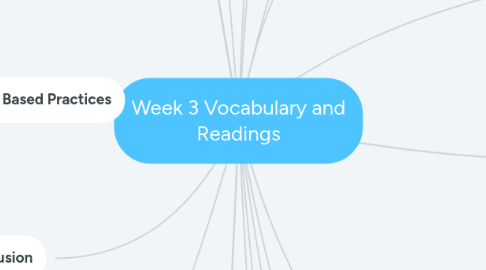Week 3 Vocabulary and Readings
by Callie Mowers


1. Parent participation
1.1. It is important to get the parents involved with their child's education, especially within special education.
1.2. Teachers need to inform and support parents.
1.3. Communication with parent and teacher.
1.4. It is said that student achievement is higher when the parents are involved and helping.
1.5. There are barriers.
1.5.1. Work
1.5.2. Other children to take care of
1.5.3. Busy schedule
1.5.4. Language barriers
1.5.5. Lack of transportation
1.6. There are ways to encourage parent participation.
1.6.1. Family centered practices.
1.6.2. Respect family characteristics.
1.6.3. Know that the families ideas of their child and their education may differ from yours.
1.6.4. Select resources that fit the family's preferences.
2. Inclusion
2.1. Offer many different ways to learn to help please all types of students.
2.2. Make sure all students feel welcome.
2.3. It is the teachers responsibility to educate ALL students and to help them to reach their full potential.
2.4. Provide resources to the students.
3. Collaberation
3.1. Parents, educators, other professionals and family members need to work together.
3.2. The goal of everyone should be to help the student to reach their full potential.
4. Universal Design for Learning and Differentiation
4.1. UDL: Lessons that include a wide variety of students and learning styles.
4.2. Differentiation: changes within the learning process so that the students needs can be met.
4.3. Plan the lessons with the students in mind.
5. Response to Intervention (RTI)
5.1. A concern is brought to attention, so an intervention is put into place.
5.2. The intervention is closely monitored.
5.3. Helps to avoid the need of special education.
5.4. RTI model
5.4.1. Schoolwide Interventions
5.4.2. Targeted Group Interventions
5.4.3. Intensive Individual Interventions
6. 2 Sentence Debate on Inclusion
6.1. Some educators urge that inclusion can only be accomplished if special education students are learning in a general education classroom. However, others argue that those special education students cannot reach their full potential in a general education classroom, so they should be taught in a special education classroom.
7. Evidence Based Practices
7.1. Educators must use data that they have collected in order to make decisions about what and how to teach their students and to evaluate how effective their teaching is.
8. Time Frame
8.1. Consent to Evaluation: 60 days
8.2. Eligibility to IEP: 30 days
8.3. Consent to IEP: 90 days
9. Gifted Students
9.1. IDEA does not provide these students with services, however some school choose to.
9.2. Students who can perform at a higher level than most.
9.3. "Advanced disablilties"
9.4. Students who are disabled and gifted refered to as twice exceptional or have dual exceptionalities.
10. Characteristics of individuals with Disabilities
10.1. Cognitive Characteristics
10.1.1. Lack of attention
10.1.2. Perceptual problems
10.1.3. Memory problems
10.1.4. Deficient thinking
10.2. Academic Characteristics
10.2.1. Reading Problems
10.2.2. Written problems
10.2.3. Oral Language Problems
